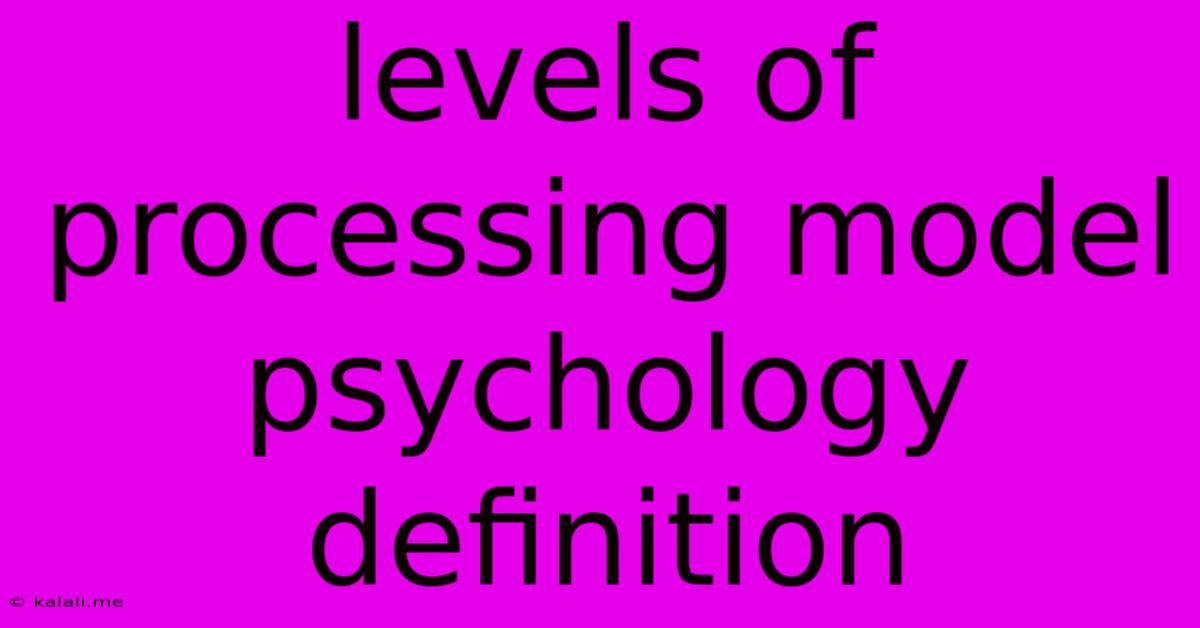Levels Of Processing Model Psychology Definition
Kalali
Jun 15, 2025 · 3 min read

Table of Contents
Levels of Processing Model in Psychology: A Deep Dive
The Levels of Processing (LOP) model is a prominent theory in cognitive psychology that explains how the depth of processing information influences its memorability. Unlike models that focus on separate memory stores (like sensory, short-term, and long-term memory), the LOP model emphasizes the type of processing, arguing that deeper, more meaningful processing leads to better retention. This article will explore the definition, key concepts, and criticisms of this influential model.
What is the Levels of Processing Model?
Proposed by Fergus Craik and Robert Lockhart in 1972, the LOP model suggests that memory is not a separate storage system, but rather a byproduct of the way information is processed. The deeper the level of processing, the stronger and more durable the memory trace. This "depth" isn't about how long you process information, but rather the degree of semantic encoding and elaboration involved.
Levels of Processing:
The model distinguishes between different levels of processing:
-
Shallow Processing: This involves superficial engagement with the stimulus. Examples include focusing on physical characteristics (like the font of a word) or the sound of a word (phonological processing). Shallow processing is often rote learning and leads to fragile memories.
-
Intermediate Processing: This level involves slightly more in-depth processing, often focusing on the meaning of words and their associations (e.g., categorizing words). While better than shallow processing, it's still less effective than deep processing.
-
Deep Processing: This involves semantic encoding; that is, focusing on the meaning and significance of the information. Examples include relating the information to prior knowledge, creating connections, and actively thinking about the implications. Deep processing often results in rich and enduring memories.
Examples of Different Processing Levels:
Imagine you're trying to remember the word "butterfly":
- Shallow: You might focus on how the word looks on the page (visual encoding) or how it sounds (acoustic encoding).
- Intermediate: You might think about words that rhyme with "butterfly" or categorize it as an insect.
- Deep: You might think about the lifecycle of a butterfly, its role in the ecosystem, or a vivid memory involving a butterfly you once saw.
Elaboration and Distinctiveness:
The effectiveness of deep processing is further enhanced by elaboration and distinctiveness. Elaboration involves linking the new information to existing knowledge, creating a richer and more interconnected memory network. Distinctiveness refers to how unique and memorable the information is; unusual or surprising information is often more easily recalled.
Criticisms of the Levels of Processing Model:
While influential, the LOP model isn't without its critics:
-
Circular Definition of "Depth": Critics argue that "depth" is difficult to define and measure objectively. What constitutes "deep" processing is subjective and often correlates with better memory simply because deeper processing inherently involves more effort and attention.
-
Lack of Specificity: The model doesn't provide a clear mechanism explaining why deeper processing leads to better memory. It describes the correlation, but doesn't fully explain the underlying cognitive processes.
-
Task Demands: The effectiveness of processing can be influenced by the task demands. For example, a task requiring a specific type of processing (e.g., rhyming) might lead to better recall even if it's considered "shallow" processing.
Conclusion:
Despite these criticisms, the Levels of Processing model remains a valuable contribution to cognitive psychology. It highlights the importance of engaging with information meaningfully and elaboratively for effective learning and memory. Understanding the different levels of processing can inform teaching strategies, study techniques, and memory enhancement methods. By focusing on semantic encoding, elaboration, and creating distinctive memories, individuals can significantly improve their ability to learn and retain information. While not a perfect explanation, it offers a crucial framework for understanding the relationship between processing and memory.
Latest Posts
Latest Posts
-
Which Of The Following Pollutants Causes Artificial Eutrophication
Jun 15, 2025
-
A Car Travels S Kilometers In 6 Hours
Jun 15, 2025
-
Lcm Of 3 6 And 9
Jun 15, 2025
-
What Is The Opposite Of Obedient
Jun 15, 2025
-
Which Of The Following Is Not A Characteristic
Jun 15, 2025
Related Post
Thank you for visiting our website which covers about Levels Of Processing Model Psychology Definition . We hope the information provided has been useful to you. Feel free to contact us if you have any questions or need further assistance. See you next time and don't miss to bookmark.